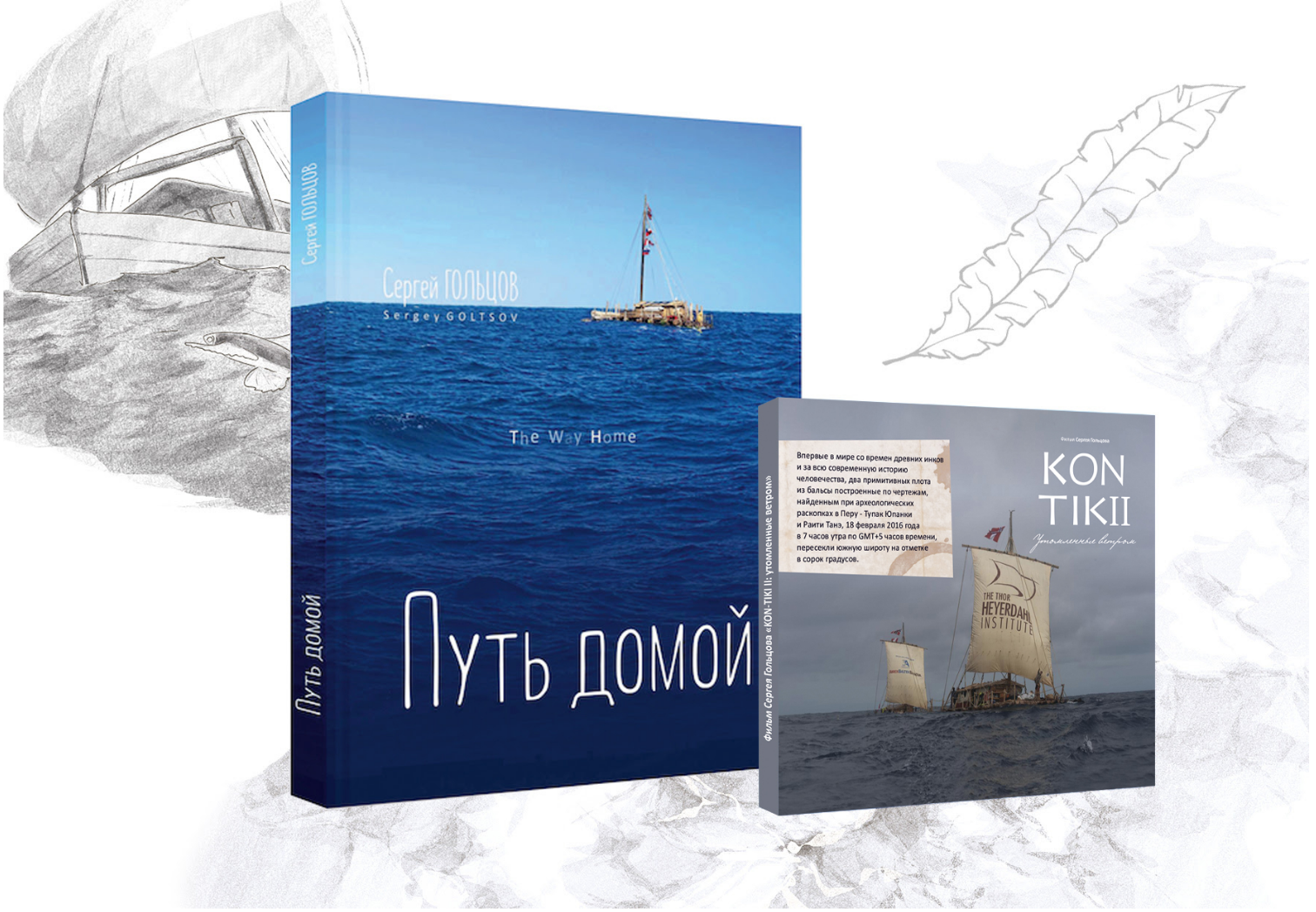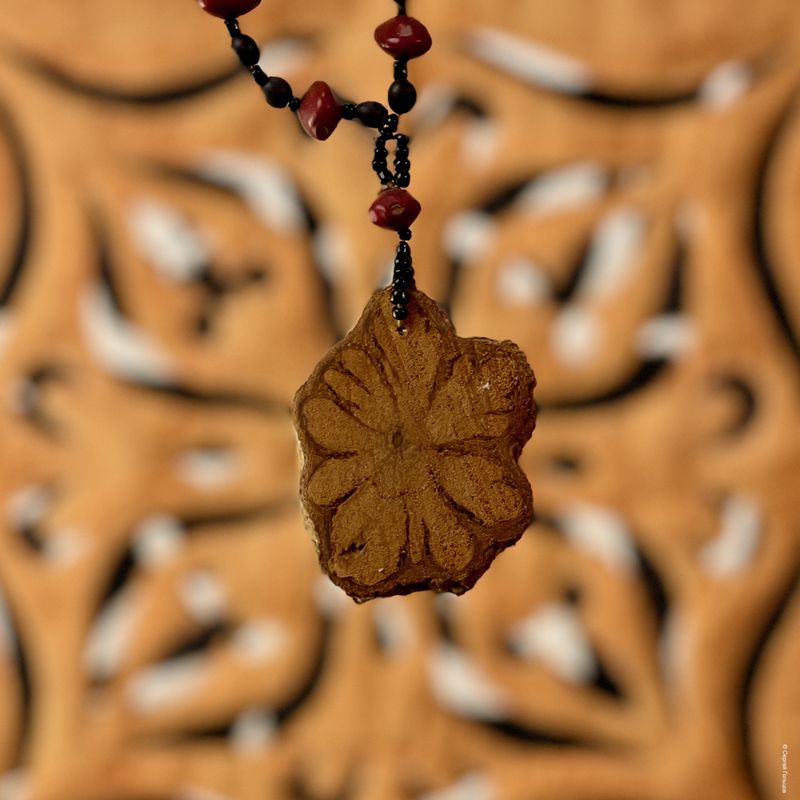On one of the days of staying with the Korowai tribe we were in a special kind of high spirits. By that time we had already stopped paying attention to the inhuman living conditions in the jungles, but started taking more and more notice of the slightest changes in the mood of the Papuans and the natural environment. All the superficial things like gadgets, electronic devices, addiction to social networks had gone away. This understanding of the situation made it easier for us to breathe despite the physical discomfort we were still suffering from due to the terrible sultriness of the fog humidity and the extreme heat.

The camp of the Korowai tribe similar to the previous one was represented by huts in the trees more than 50 meters high, entirely for the safety reasons.

Not that long ago, such houses were built during the tribal warfare though these wars had a local character without a mandatory feature of all wars – the expansion, in other words these wars were made in order to humiliate the enemy (by stealing their women) and to kill, but not to invade the territory and to annihilate the enemy tribe. As the protein-based food was extremely insufficient, just as have already mentioned, no wonder that the flesh of a defeated enemy was considered a good award. Nowadays the tribes live on relatively friendly terms as they use different resources: the Asmat people feed on the things the river gives them and the Korowai people eat what they find in the jungle. One protected all-round house on the tree usually accommodates a family of five. They live for 2-3 years on one and the same place feeding in an amount of one sago palm per two weeks. When all the palms are eaten the family moves to another place and the history repeats itself.
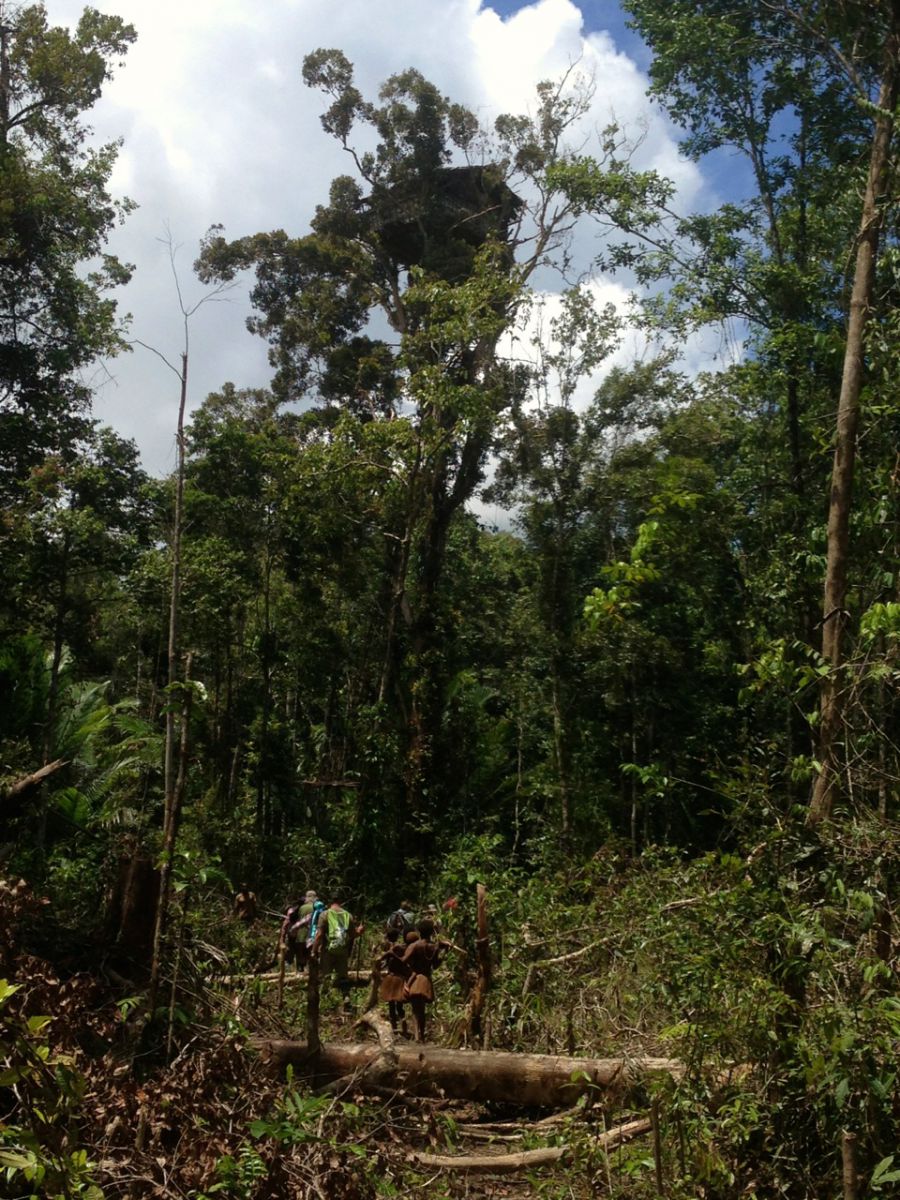
In addition to the houses on the tree tops there was a long hovel on the ground with a welcoming fire inside. As we found out it was used for special occasions.

We were just in time for the feast of collective eating… no, not the guests with fair skin but just grubs of the sago weevil – a type of rather a big beetle which lays grubs in the sago palm, the former being a delicacy for the jungle Korowai. But first things first...

We were met by the tribesmen quite friendly as they were happy to see Anton again (our guide who is painted in black in the photo), and the latter made no disguise of being glad to have the opportunity to see his people. Anyway it seemed to us this way though the Korowai do not have any kinship.
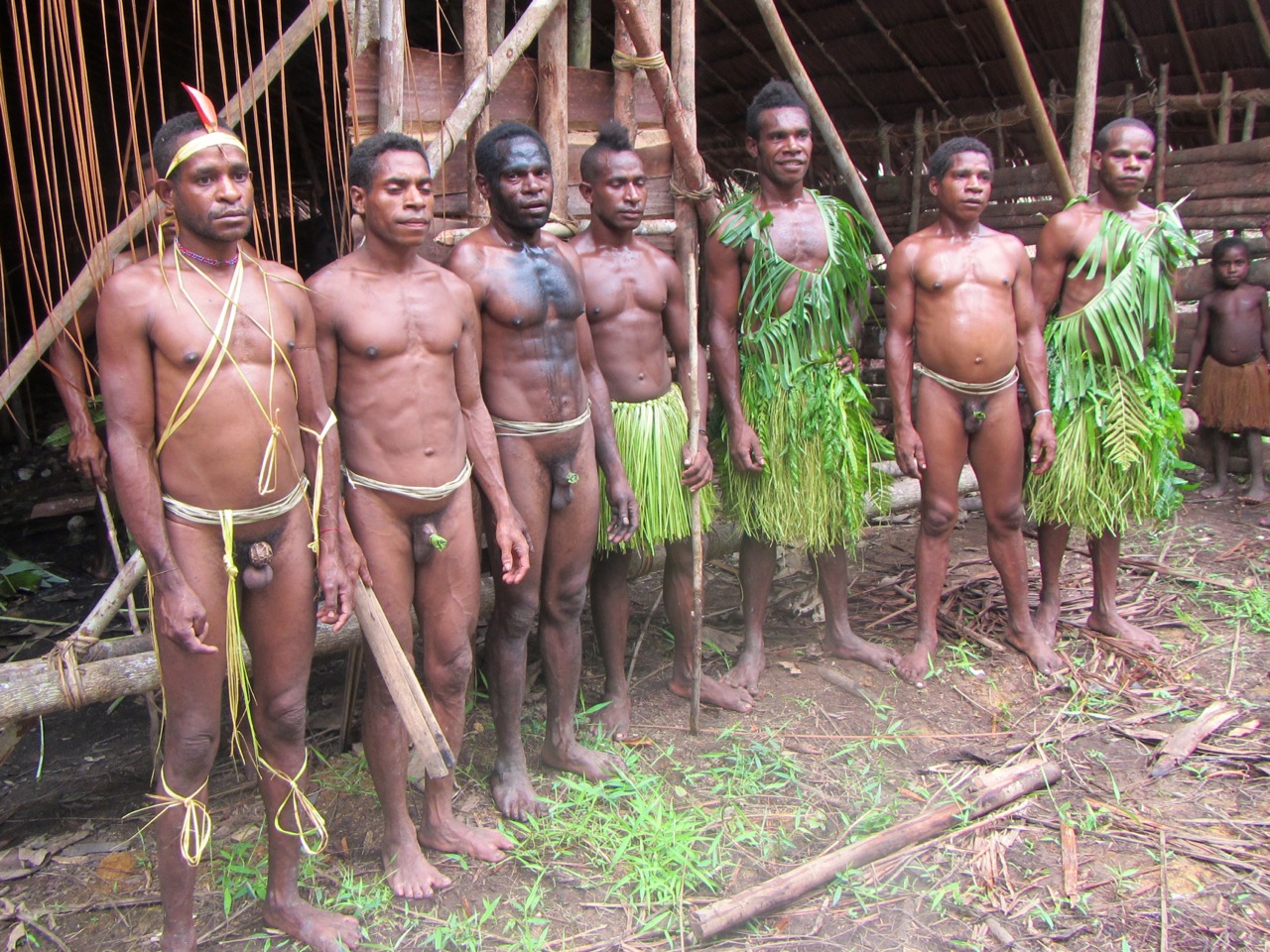
Thus we were expected to take part in cooking the basic element of the Korowai diet: scones made of the sago flour with grubs. Hmm...
When the suitable palm was found the tribe set to work.
.jpg)
Some people worked by sweat of brow and others just watched, just like in our world...

Despite the stone tools (the Korowai refused to take the axe which we offered) the palm was defeated in about an hour accompanied by the general jeers and enthusiasm. It fell to the ground making a lot of noise when clinging to lianas and branches of other trees...
There was something special in this ritual: small though slim, acting as a team in such a fuss and accompanied by some inhuman sounds, just like the Lilliputians around Gulliver, they made their meal quite confidently and without haste as many thousands of years before.
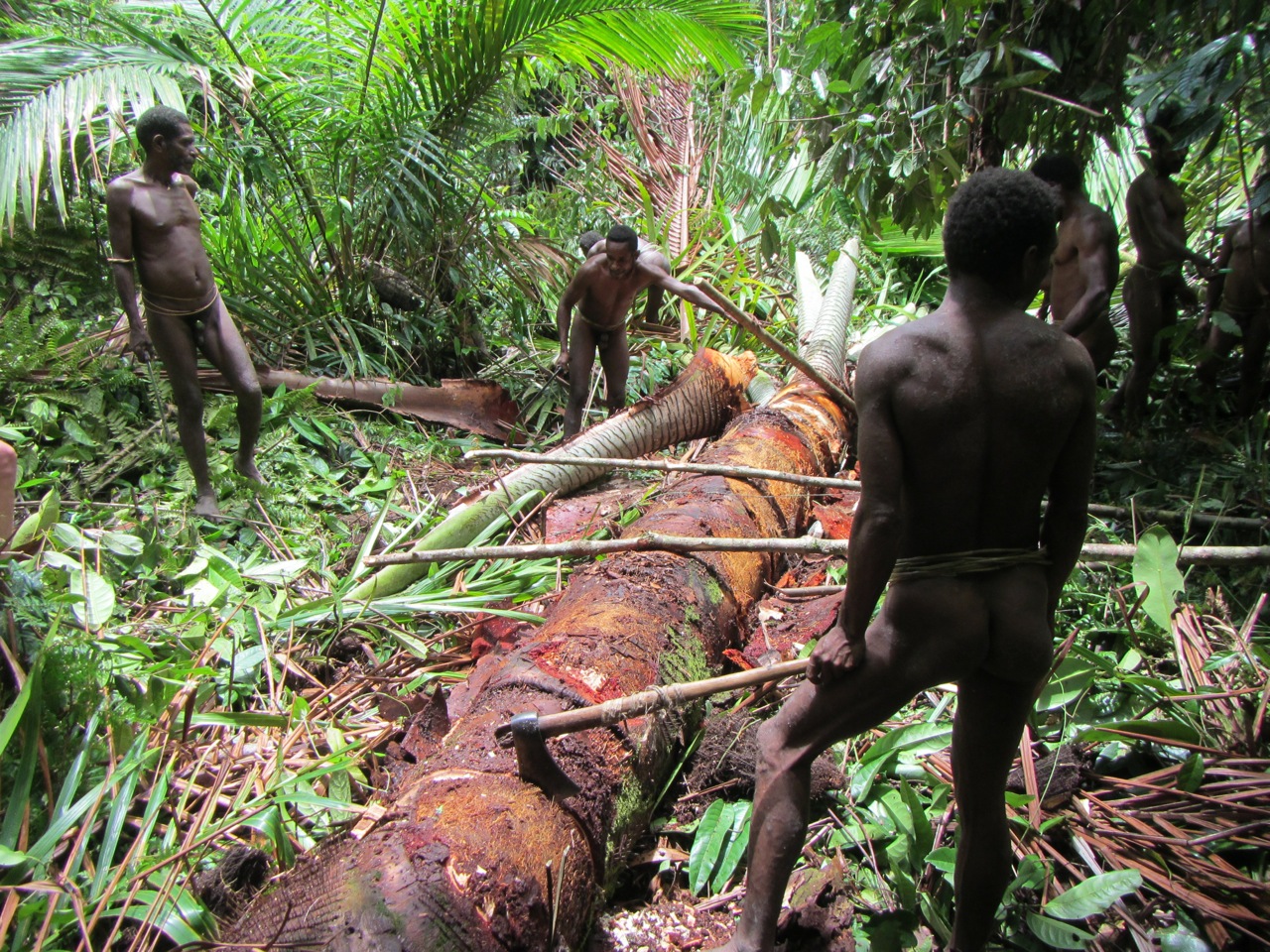
So the men started dressing the trophy by clearing the 10-meter trunk off the bark, hairy and very thorny in some places.

I should say that the whole palm is utilized and that’s why it is extremely valuable to all the jungle inhabitants. It gives food – the sago flour; and construction materials for the walls, the floors and the roofs of the huts; troughs for fishing and offhand water pipes; leaves used as utensil, and bark as a warrior’s shield.


Meanwhile, the sago weevil hurried to land on the palm freshly sheared surface.
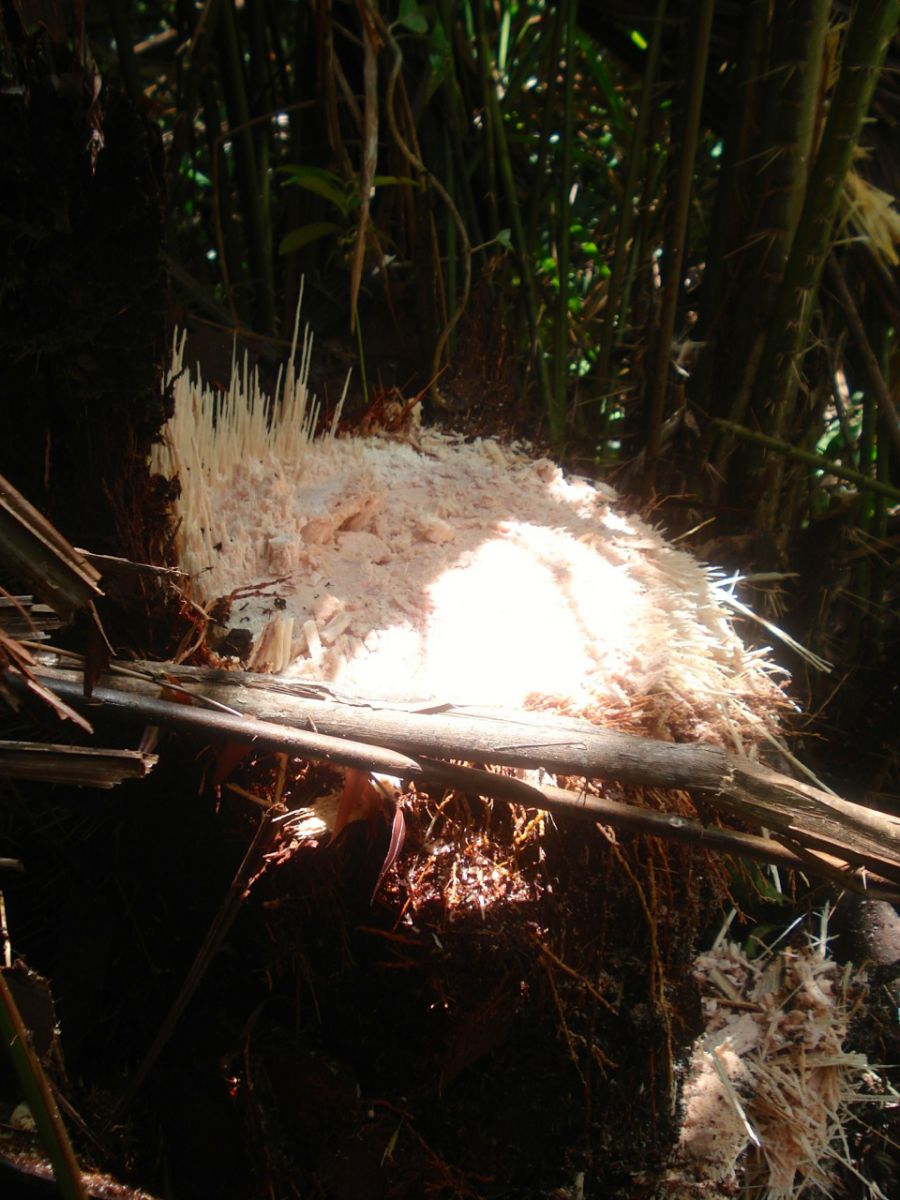
The beetle was not long in coming and in a few minutes it settled on the palm sheared surface.

I decided to taste the sago palm pulp as I had been pretty hungry by that time. It was rather tasty, I should say, and reminded of the sweet turnip.

The sound of the falling palm made the women and the children come to that place out of the jungle, and when they appeared I just felt inclined to look at them through the eyes of the first explorers...

Some tribesmen were no less sincerely surprised by the appearance of the women.

Actually, the life of the Korowai men is not that easy: they have to build houses, to protect the tribe and to cut the sago palm. By the way, while the palm was being cut the children were standing nearby waiting for the tasty food and the women were thoughtfully smoking...

Later I saw the reason of their thoughtfulness.

The woman does almost all the work necessary for the family to survive: she makes flour, looks for the grubs from the sago palm, fishes and brings up the little children.

Armed with bamboo hammers the women began hitting the palm pulp together encouraging each other with singing songs and quickly getting the sago flour
which they put into bundles and then carried to the prepared troughs.

The men watched the women with great interest.


But as our experience tells us, sooner or later the working people get bored and… they cry different slogans in the position of a revolutionary.:)

Having improved the tools and replaced the women the men took up the matter! Here is Anton. Some months ago Anton left his tribe in search of a different life. Now he wears clothes, earns a little money and eats rice instead of insects. But he did not break off relations with his tribesmen. These are the tribesmen he brought us to.
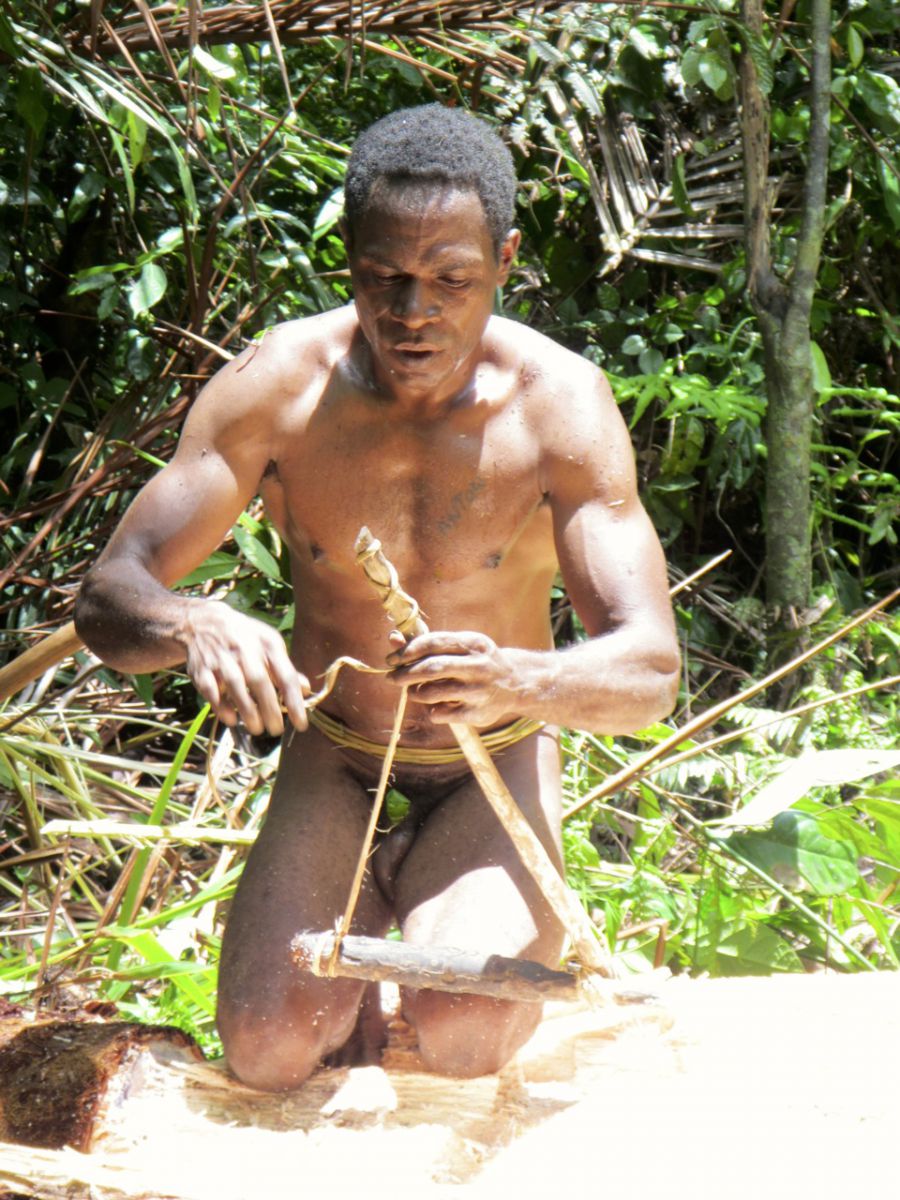
The intersection of cultures with Anton being the center of it is a wonderful place both for us and for his tribe, as it turned out. Anton dreams of finding the life different from the one of the Korowai people. He does not want much: just his own house in the city, some money and a cow, he wants to do something considerable in this life! And all this seems so familiar to us...

Keeping in mind that the Korowai people can eat even their relative who showed great physical strength while being alive in order to transfer this strength into their bodies, we took part in cutting the palm just as spectators.

This process is very labor-intensive and requires coordinated teamwork of all the tribesmen. Both of men and women.


I have already told that a woman is the greatest value and a woman having children is twice more valuable!

Everything is for them!

This may be the reason why they are sometimes permitted to break rules. The story is as follows. Once a manfrom the hostile Kapayaki tribe got lost and accidentally found his way near the Korowai camp, and he could have been eaten for sure but for… the familiar tribe’s woman-leader who saved his life as well as married him! :) This is love!

Then she said: let him bring a killed snake, a stone axe and something of this kind. Now he lives with their tribe but throughout his life he has to wear a leaf on his left hand. These are the metamorphoses! :)

This is the daughter of the tribe’s leader. Anton said that she would soon be abducted as she had reached sexual maturity...

Meanwhile, having brought the last bundle with flour the old woman began cooking.

Pouring the water from the swamp to the flour placed in the troughs

she squeezed and drained it off.

Running down the water accumulated in the lower trough
turning into pure starch.

By the evening they had presented us with the pressed starch.

Injuries have always followed the process of cutting down the palms.

I wonder how they manage to survive without medicine and having even no quackery… But not this time! They were watching my shamanic operations with the first aid kit strongly reacting to every action!

After giving presents we finally understood the meaning of the phrase “mano telabo” which is a good person.
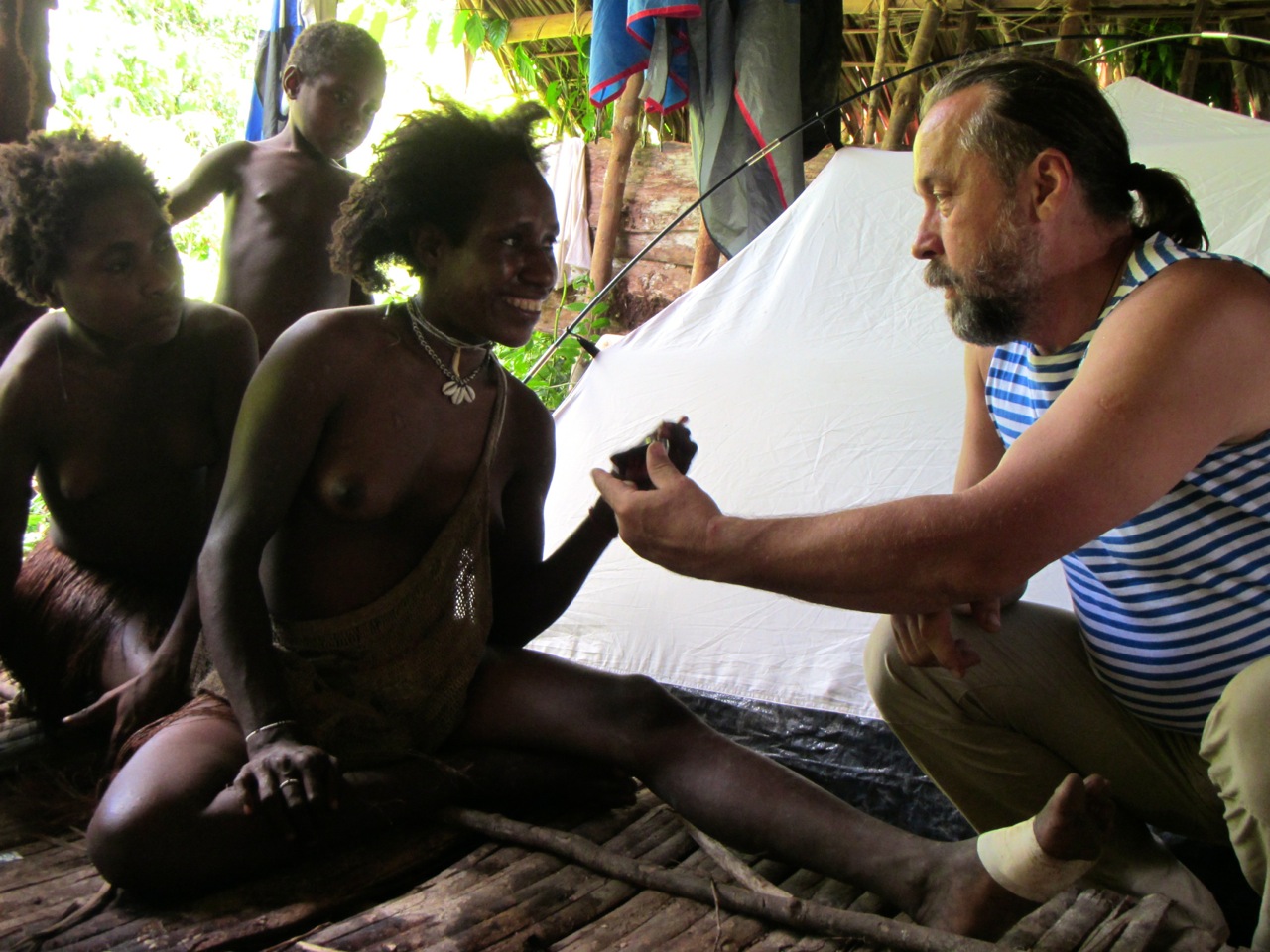
An evening get-together revealed more and more details of the tribe’s life.

The Korowai people live on trees for the safety reasons bewaring of attacks of other tribes and snakes. They live in families and practice polygamy though women with children and men live in separate houses.
Young Korowai people (just like in our world) leave their home in the hope of living a more civilized life which the Government of Indonesia offers them allocating more than 3 thousand dollars per month, and the elderly tribesmen stay in the jungle keeping the traditions of the Stone Age.
The process of making a family is also traditional: the mother looks for a fiance for her daughter watching the guys at work and choosing the most skillful one. Then she proposes her daughter to the guy and he should present her with the necklace made of fangs and seashells which are brought to this place through many intermediaries and are highly valued among the Korowais.
.jpg)
In the morning we all took part in the Feast. One of the warriors made a fire with a rattan thread within minutes.
Another man put the stones into the fire to use them later for cooking sago scones.

Then they put some sago flour on the freshly cut palm leaves

and began stuffing it with grubs still alive and moving.

Having folded the stuff into a palm leaf this patty was then tied up with a thin liana and was put on the red-hot stones.

Together with the Papuans we were waiting and looking around us.


I almost forgot to mention that before cooking the grubs the Korowai people performed the ritual of evil worship (they do not know the good spirits) when they sang a song (or to be more precise, produced the sounds though keeping the beat), ran around the camp and the fire thus calling upon the evil spirits to grow stronger.
Back to the kitchen again… Moving the stones in the fire to keep heat on the “cooker"

they prepared the festive dish in 30 minutes!

The Chief of the tribe cordially offered us to share the food with them...

The dish looked quite appetizing. It was subject to thorough thermal processing right before our eyes, that’s why they did not have to persuade us long!:)

If to take into account the fact that we had eaten raw grubs before I should say that roasted in the sago flour they were fantastic!


During dinner we talked and learnt some more facts about life in the jungle. We learnt that the new born babies got the names of plants, they did not have the notion of love and of “satisfying a woman”: they do not understand it and as a consequence the coituslasts a few seconds but always results in impregnation.

No doubt, this fact is of great interest from the scientific perspective. That’s why being at constant “sperm wars” men possess a relatively small penis (up to 5 cm which they cherish as the apple of the eye) as compared to the incomparably big scrotum.

The Korowais live 40 years in average. During all these years the men are capable of inseminating, like in the wild world, that’s why they generally eat little boys roasting them in the sago palm as they do not need rivals around. The question about the age brings them to a nonplus.
The aboriginals do not have notions of time and chronology. The only thing that matters to them is that when attaining the age of majority every young man must go through the coming-of-age ceremony: he must kill an enemy and bring his genitals or head or a lower jawbone to the tribe. Just after this he can be called a man. It is strange, but there is a tribe of the Amazons in Papua who live in the mountainous part of the island. Once a year the Amazons come down to the jungle and the jungle Papuans get into sexual relations with them. The Amazons control this process quite tough holding a bow with an arrow in a pulled string at the Papuan’s head. The Amazons are cannibals as well: they eat all the new born baby boys keeping the girls alive.
The blows of a big log interrupted our conversation. The Korowais began dancing and running again holding their arms thus rejoicing over the Feast presented to them by the jungle.
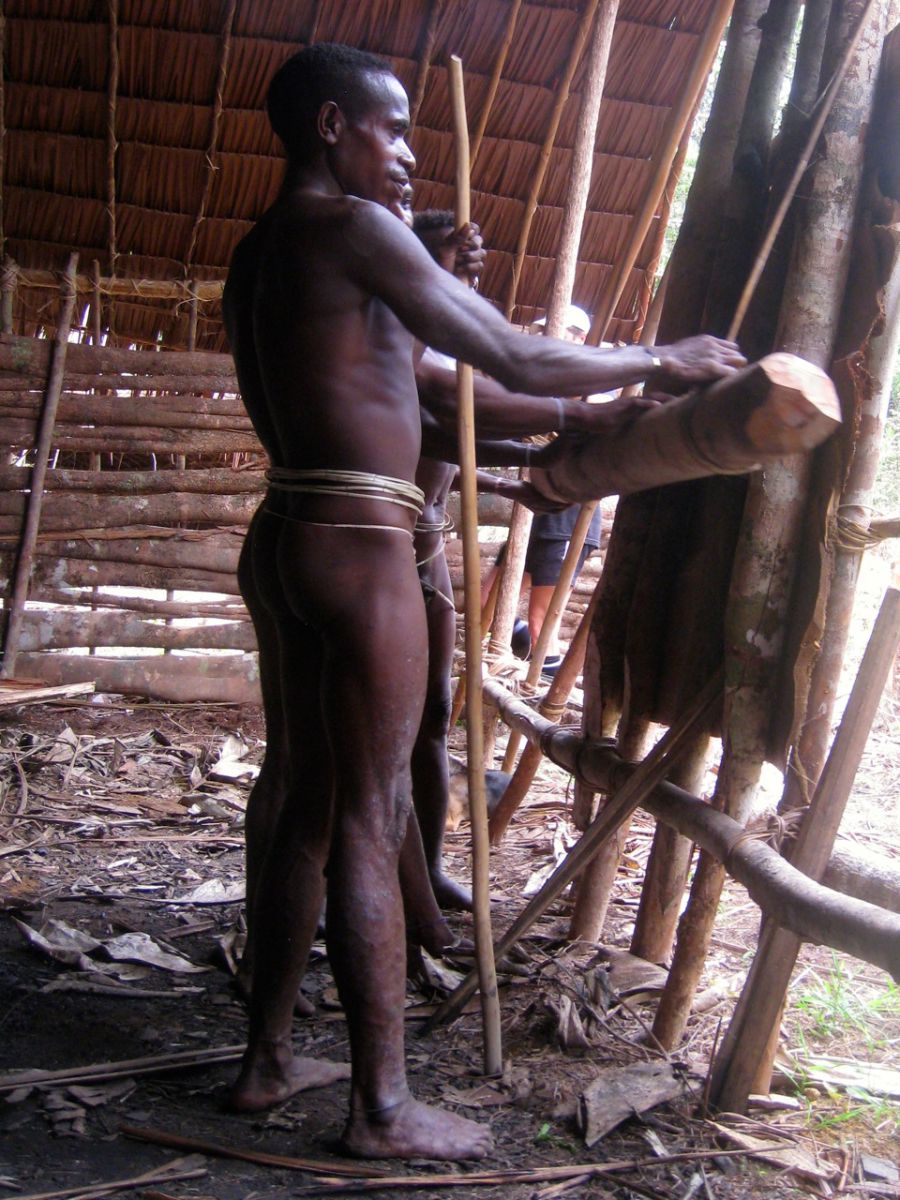
When we watched them eating the scones with grubs we stopped fearing at that moment that they were cannibals.
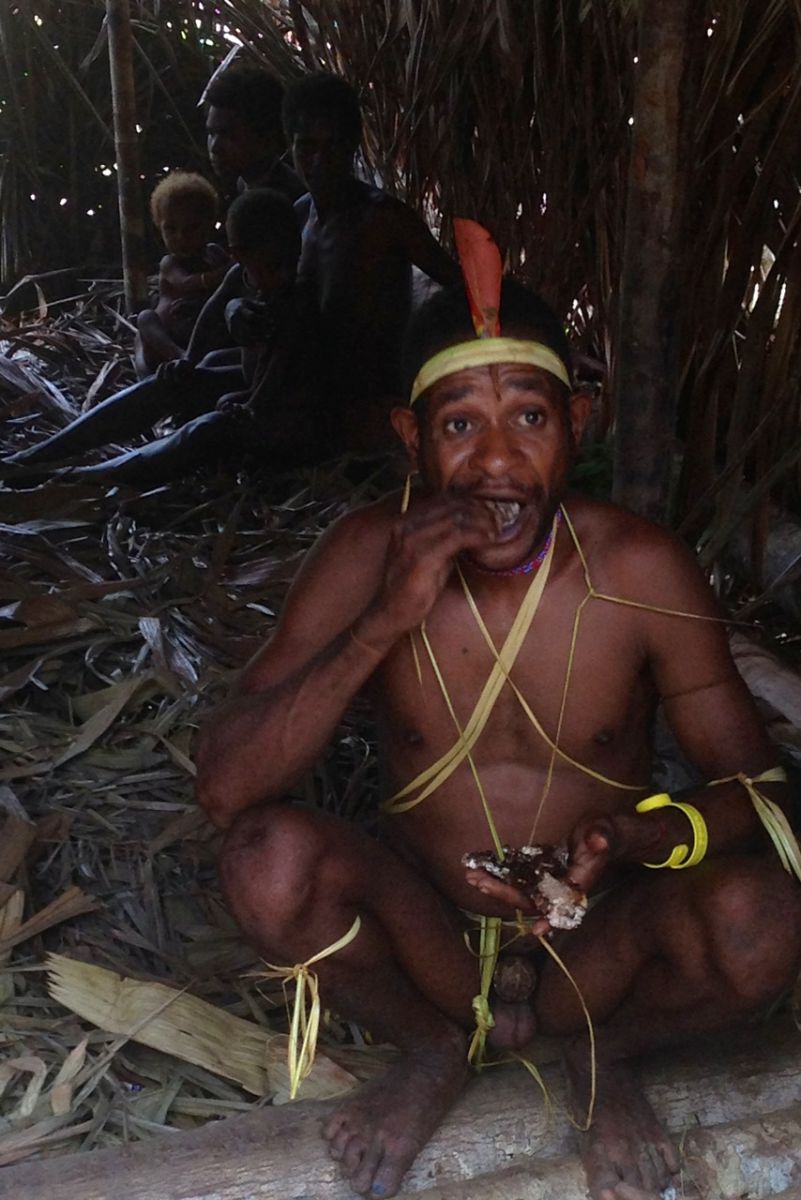
For the Korowais this is just the way to survive in the terrible conditions of the tropical jungle. The evolutional transformations had some impact on them and played a low-down trick on us having turned them into bloodthirsty cannibals in our consciousness.

Nobody knows how we would behave if we found ourselves under these conditions armed with the equipment as well as sophisticatedmeans of annihilation of the human beings.
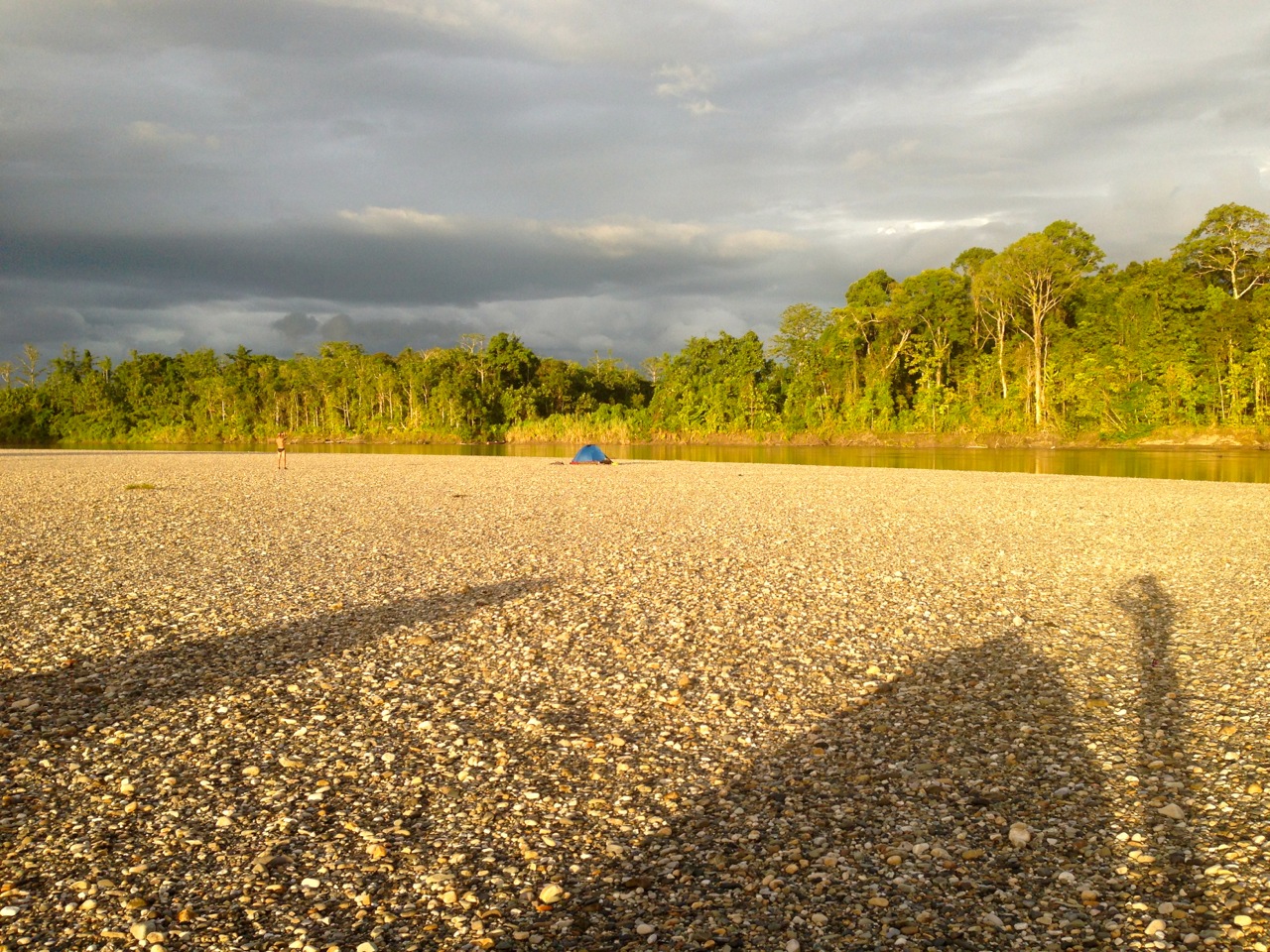
This could be the very thought which came to Anton’s mind: a Korowai man, our guide, the cannibal who ate more than one enemy and the person who saved his parents having killed them instead of leaving them to the enemy, a Papuan who knows the laws of the green as well as of the grey concrete jungle, unlike us and his tribesmen. And it seemed to me this jungle is easier for him to live in, somehow more honest...

A feeling of sadness seized us and the Korowais for the twentieth time on this island far away from our Motherland.

We were taking leave in silence and we knew that we would never see each other anymore.
The jungle warriors and lords, the tribes lost in time with static culture and evolution taught us so much during these days. Did we teach you at least as much? Nobodyknows... But I hope we didn’t do harm at least...
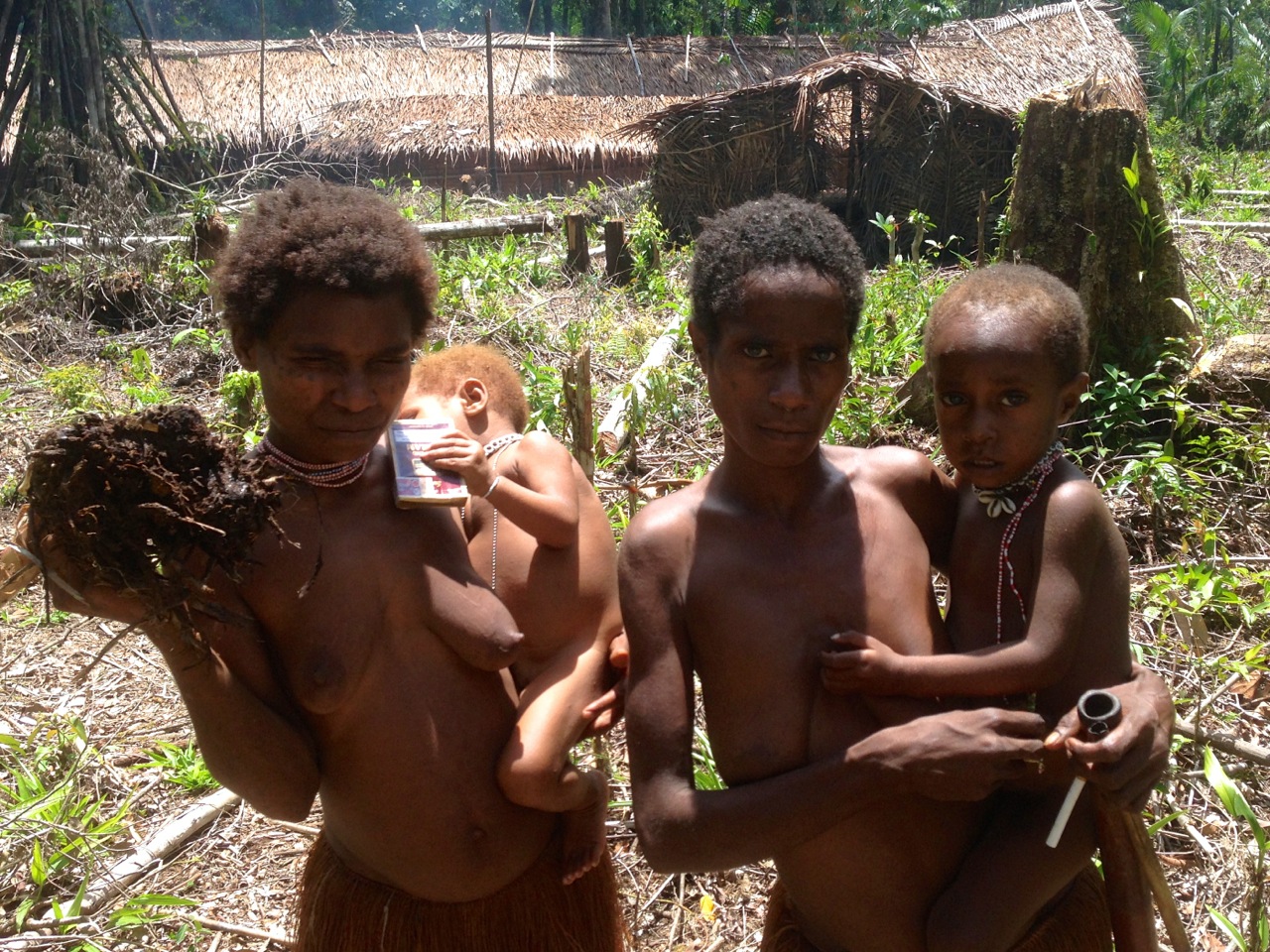
That’s about it! :) Despite the fatigue accumulated for the last three weeks the way back home was easy and full of emotional reminiscences which already called for new roads and discoveries…
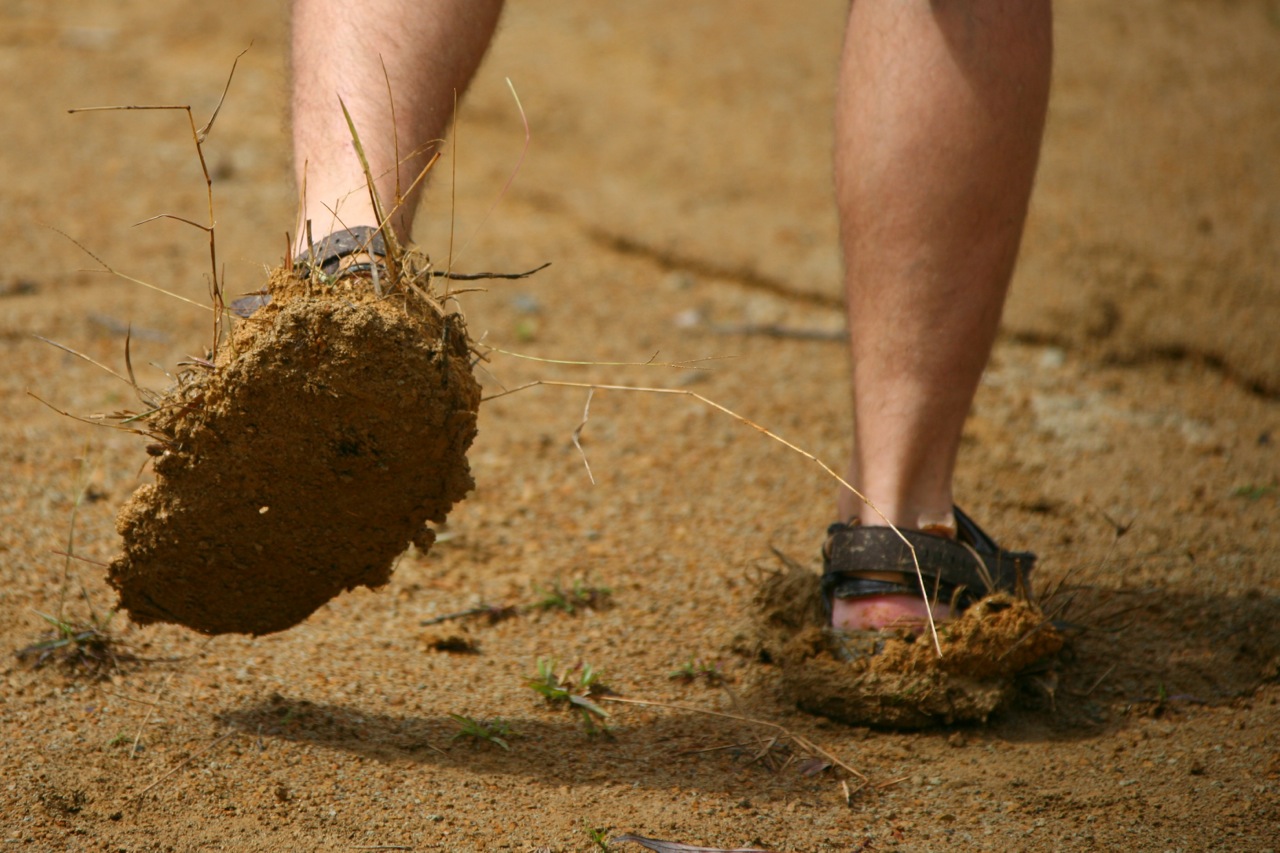

















.jpg)





































.jpg)
























